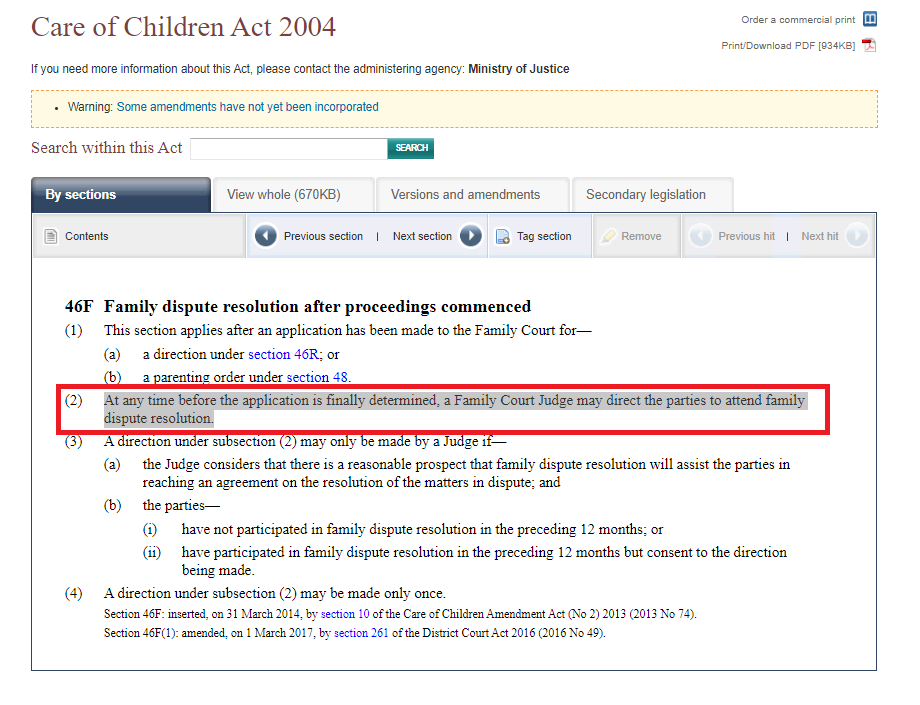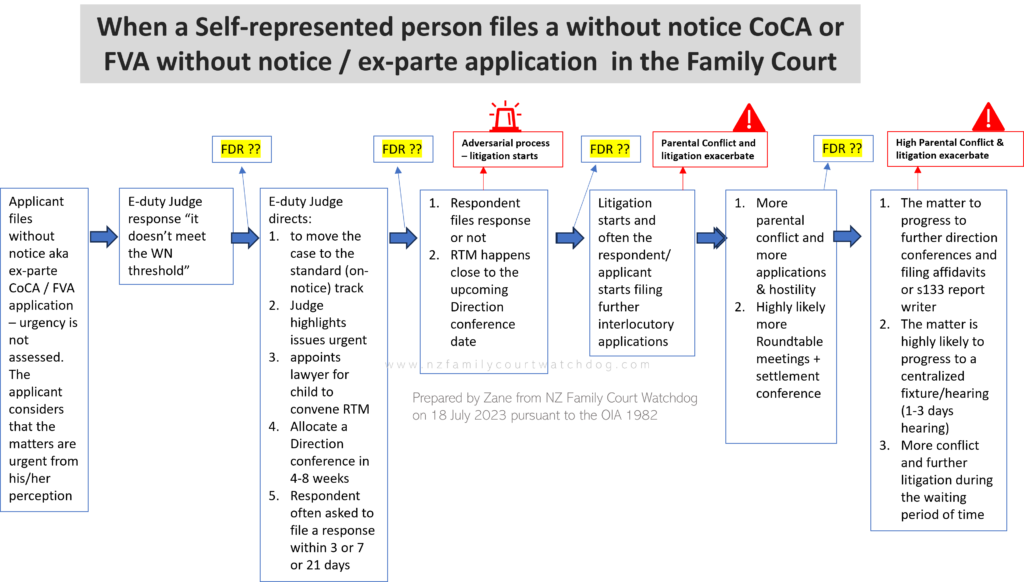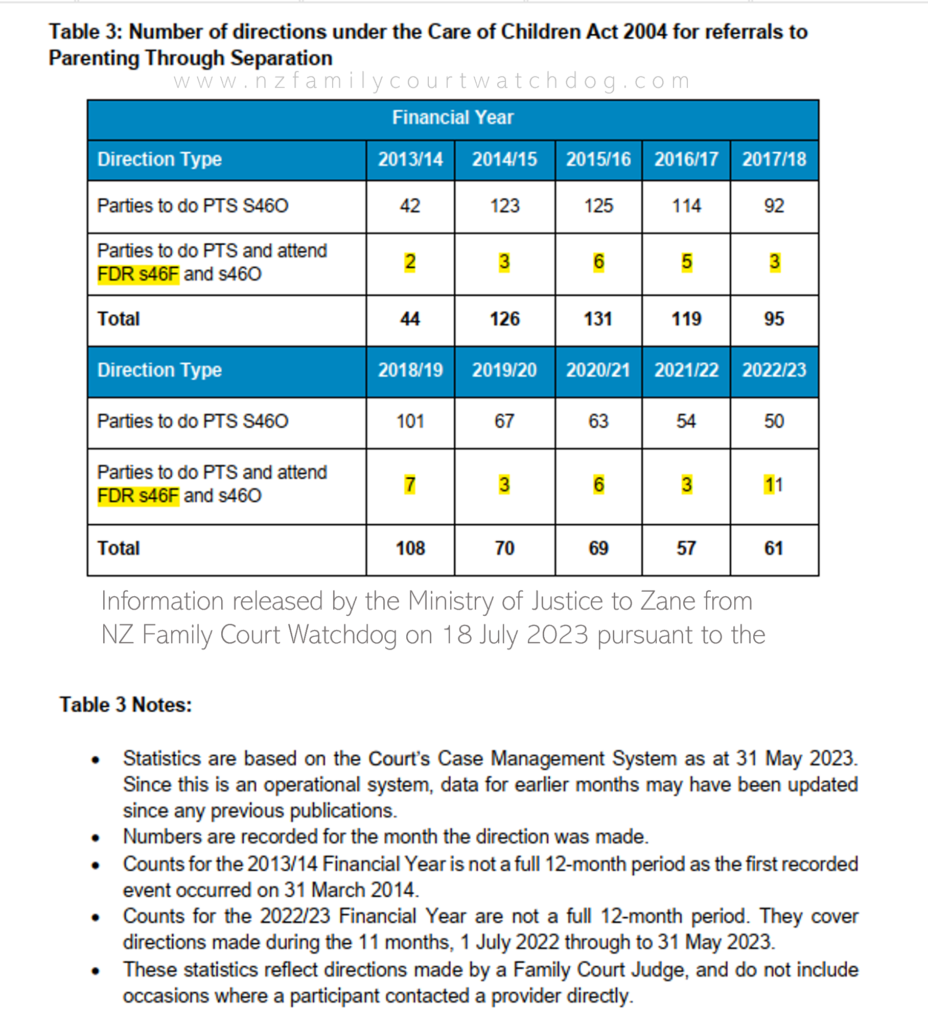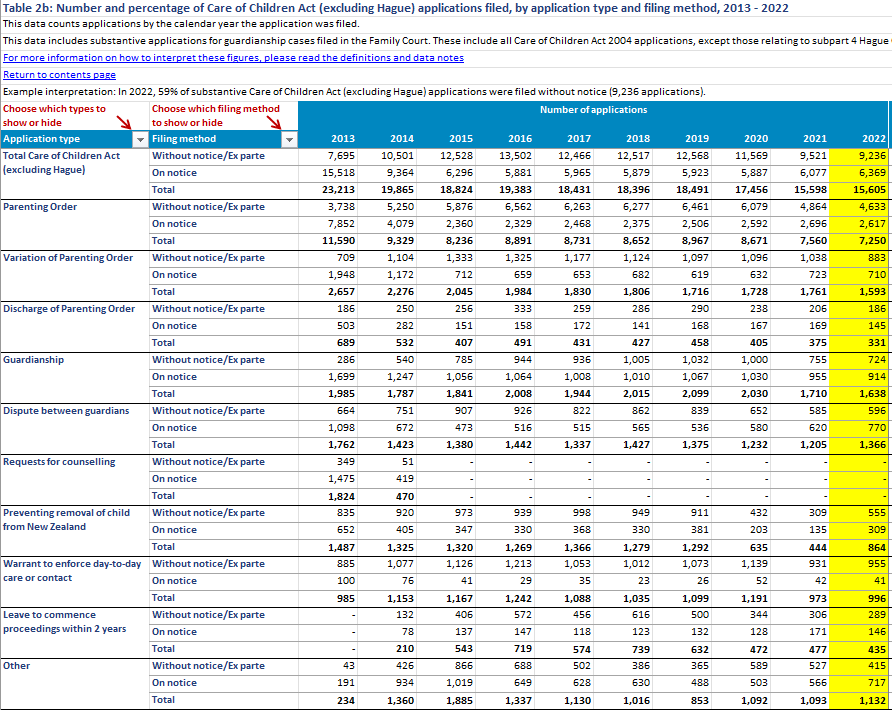Common Scenario inflaming litigation not encouraging out-of-court resolution?

Section 3(2)(d) – Purpose of the CoCA 2004 was intended to encourage agreed arrangements between the guardians of the child and provides for the resolution of disputes about the care of children.
The 2013 Family Court reform was introduced through the enactment of the Family Dispute Resolution Act 2013 and the Care of Children Act 2004, after the introduction of the Care of Children Amendment Act (No. 2) 2013. Since 2014, attending a Parenting Information Programme (PIP), also known as (PTS), and a Family Dispute Resolution mediation is mandatory for parties before commencing court proceedings for parenting orders and guardianship directions.
Why only few cases are referred by Family Court Judges to FDR /Conciliation after the proceedings commencement?
The focus in this article is on Section 46F(2) of the care of children act 2004 that empowers Family court Judges to refer cases to FDR after the proceedings are commenced.

Common Scenario A

Apparently, some self-litigants and lawyers misuse the without-notice track application process vexatiously or maliciously, or to bypass the normal procedures, often fabricating urgency and for other wrongful purposes. Personally, I do not condone the abuse of the court process, but it is available for Family Court users and can be easily misused.
To be completely honest, the on-notice standard track process is very expensive, lengthy, and involves numerous procedures and requirements. Some self-litigants use it inadvertently to expedite their applications before a Judge, as highlighted in an RNZ Audio interview with Women’s Refuge CEO. When the e-duty Judge receives a without-notice application for a parenting order, they are obliged to make a decision within 24 to 72 hours without hearing the other party’s side of the story (Common Scenario A above).
The problem with this process is that if an applicant wishes to file their application on the on-notice track, there are many requirements, such as completing the PTS course and attempting to initiate the FDR process, among others. In summary, the on-notice application process is very time-consuming, and in some courthouses, it may take up to 3-6 months for the application to be placed before a Family Court Judge. Additionally, the respondent can also abuse the process by not responding for many months. As a result, the majority of self-litigants or parents represented by lawyers opt for the without-notice track process to efficiently bring their case before a Judge
The common Process after filing a without-notice application:
“Throughout our experience dealing with many self-litigants’ cases and after reviewing hundreds and thousands of Judge’s memoranda, minutes, and decisions in response to numerous without-notice applications filed by self-litigants and lawyers, it has been observed that when some of those applications don’t establish the high threshold set for without-notice orders (see Martin v Ryan [1990] 2NZLR and FCR 220).
In most cases, the process to deal with the application moving forward follows the above flowchart. There have been only a few instances where the cases were referred to FDR (Family Dispute Resolution) instead, but more often, the process runs as outlined in the above flowchart.
It is important to note that the without-notice track should only be utilized when the situation genuinely meets the criteria and urgency set out in rule and FCR 220. Otherwise, the matter may be more appropriately handled through the standard on-notice track, which involves following additional requirements such as completing the PTS course and initiating the FDR process.
Often, the process to deal with those WN applications moves forward as per the above flowchart; we have only observed a couple of cases (over a decade reading thousands of e-duty judges’ decisions) which were referred to FDR instead, but often the process goes ahead as per the process of (Common Scenario A) above.
We have dealt with hundreds of similar scenarios (Common Scenario A) above, and based on our experience, it is rare for a Family Court Judge to refer the parties to Family Dispute Resolution (FDR). While we make efforts to encourage parents to engage with FDR, the majority of them refuse for the following reasons
- Some parents prefer to proceed with Roundtable meetings led by the child’s lawyer because they believe it is a free and faster option. They may have the misconception that Roundtable meetings are more efficient and cost-effective compared to FDR.
- Many parents assume that Roundtable meetings (RTM) as a more appropriate platform where they can be heard by the appointed child’s lawyer, and they believe that their concerns will be addressed more efficiently.
- On the other hand, the FDR process receives criticism from many parents, who argue that it is not free, and they express concerns about the perceived lack of power held by the mediator. They also raise issues about the delays in starting the mediation process.
Below are the numbers of referrals to s46F made to FDR :

Statistics obtained from the Ministry of Justice
The statistics obtained from the Ministry of Justice in this article below, particularly the number of “Applications still alive” in 2022, are very concerning. However, it seems that specific statistics regarding the number of applications filed on the without-notice track, which were later to be ontained not to meet the threshold, have not been obtained or are unavailable.
In 2022, 59% of substantive Care of Children Act (excluding Hague) applications were filed without notice (9,236 applications).
In 2022, 41% of substantive Care of Children Act (excluding Hague) applications were filed on-notice (6,369 applications).
“In summary, the main concern we are attempting to highlight in this article is that despite the excessive number of applications filed in the Family Court in the year 2022 (a total of 15,605 applications, comprising 9,236 Without Notice (WN) applications and 6,369 On-Notice applications), there is a lack of information regarding how many of these Without Notice applications were ultimately deemed not to meet the required WN threshold.
This information gap may raise questions about the efficiency of the Without Notice track and the need for a more thorough evaluation process to prevent vexatious or inappropriate applications from clogging the Family Court system. It also emphasizes the importance of ensuring that only legitimate and genuinely urgent cases are filed under the Without Notice track, while encouraging parties to consider other dispute resolution methods like Family Dispute Resolution (FDR) to alleviate the caseload of the Family Court.”
Why do we have very less referrals to FDR or any other conciliation services after the proceedings commencement? ?
Upon closer examination of the provided table, it becomes evident that concerns are related to ‘Common Scenario A.’ The data clearly indicates that the number of applications referred to Family Dispute Resolution (FDR) has been consistently low since 2013, spanning a period of ten years. On average, only about five cases per year, nationwide in New Zealand, have been referred to Parenting Through Separation (PTS) and FDR combined after the commencement of proceedings.
This information raises questions about the promotion of FDR as the preferred alternative for family dispute resolution. It suggests that despite the availability of these dispute resolution services, a significant number of cases are not being directed toward them for resolution. This could indicate that parties are either not being adequately informed about FDR and its benefits or that Family Court Judges and lawyers are actively choosing not to promote these options.
I propose that in cases where self-litigants or parents represented by lawyers file applications that do not meet the without-notice (WN) threshold, they should be directed to attend Family Dispute Resolution (FDR) before their applications proceed further. This could involve placing their applications on hold or striking them out pending the outcome of the FDR process. Such an approach has the potential to enhance the efficiency of the Family Court system and benefit all parties involved. However, implementing this process would require a thorough examination of its feasibility and the legal rights and expectations of the parties.
Given the potential benefits of Family Dispute Resolution (FDR) and Parenting Through Separation (PTS) in facilitating communication, cooperation, and mutually beneficial resolutions in family matters, the consistently low utilization rate of these services demands closer examination. It underscores the importance of actively promoting FDR and PTS to parties involved in family disputes. Additionally, improving education and awareness about these services can contribute to a higher rate of cases being successfully resolved through FDR and PTS, ultimately relieving the burden on the Family Court system.
Some of the comments in the Without Notice Applications in the Family Court: Research Report – July 2017 highlighted as below:
Report title: Without Notice Applications in the Family Court: Research Report – July 2017 – para 92 to 96Not urgent – time-sensitive concerns
The applicant has a sense of urgency despite the fact that the application does not meet the threshold criteria of serious risk and safety concerns. However, from the applicant’s perspective, there are pressing concerns that need to be dealt with promptly. What interviewed applicants state (and participating judges, lawyers and Family Court staff largely agree with) is that this type of without notice application is declined (i.e. no interim order). However, research participants also spoke of cases in which judges directed the application be placed on notice while remaining on the without notice track.
In cases where without notice applications are declined, the judge is still able to make a range of directions including directing applicants to complete FDR.
From the perspective of interviewed Family Court staff, directives by judges to complete FDR do not seem to be made often.
The three Judges interviewed in this research commented that FDR had merit and was a valuable
tool to aid resolution of issues, but that there was also a stated preference to utilise directions
conferences and only refer to FDR if they felt it is appropriate.FDR was seen as one of the pathways towards dispute resolution. It appears from our limited
engagement with the three Family Court judges during this research that they are highly aware of the responsibility that comes with their position, care deeply about the impact of decisions they make, consider the facts and needs of both parties and then decide on the most appropriate response.


It is indeed deeply concerning to observe such low figures, with an average of only five cases per year being referred to Family Dispute Resolution (FDR) out of the thousands of cases processed. This observation becomes particularly troubling when considering Common Scenario A. It appears that Family Court Judges may not be fully utilizing their authority to direct parents toward FDR, despite having the power to do so.
![]()

